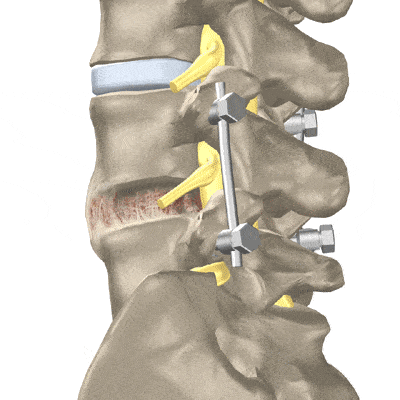Definition:
Spinal fusion surgery is performed to treat the diseased conditions related to spine by fusing and joining two or more vertebrae. The fusion immobilizes the vertebrae and the restriction of movement will eliminate the pain and other symptoms.
Why it is needed:
Spinal fusion is done mostly at the lumbar vertebrae. The surgery is advised to treat the back pain or some neurological deficit which has not responded to conservative treatment that includes:
- Degenerative disk disease
- Spondylolisthesis
- Spinal stenosis
- Scoliosis
- Fracture
- Infection
- Tumor
Facts and Figures:
- Among all connective tissues of the body, the most serious age related changes occurs at the intervertebral disk connective tissue.
- First Russell Hibbs and Fred Albee developed the concept and methods for bony fusion of the spine to treat the Pott disease in 1911
- According to published data, more than 400,000 spine fusion surgeries are performed in the United States annually
- The spectacular increase in the number of fusion surgery had been observed in past two decades in American population.
Advantages and Disadvantages:
Advantages:
- Spinal fusion surgery makes patient’s life more comfortable by relieving pain, numbness, tingling and weakness etc
- Improves the posture of patient
- Spinal lumbar fusion increases stability of the spine that reduces the chances of injury to lumbar spinal area and in cases of severely injured spinal vertebrae the spinal fusion decreases the chances of further injury and promotes healing.
Disadvantages:
- The premature and inappropriate fusion procedures can result in “Failed Back Surgery Syndrome”
- Chances of failed fusion makes patient so suffer from the same problems after the surgery
Risks and Complications:
- Reaction to anesthesia or medication
- Infection
- Blood clots
- Bleeding
- Damage of the spinal nerve, can lead to paralysis in later stage
- Pulmonary embolism
Pre-operative and Post-operative care:
Pre-operative preparation:
- A complete physical examination
- Blood and urinalysis
- X-rays and MRI
- Visit to a physician and have a list of the medicines which are to be taken or needed to be stopped before surgery
- Inform surgeon related to any habits of smoking or alcohol. Quit smoking.
- Arrangement for leave from work, help at home, help with driving, and for post operative rehabilitation
- Do not eat or drink anything after midnight the night before surgery
- Medical tourist are advised to select handicapped accessible hotel room near the hospital for post surgery recovery
Post-operative care:
- Most patients are required to stay at hospital for 4-6 days after the operation. Medications will be given to relieve pain.
- First few days following surgery the spine needs to be kept in the right position to maintain alignment. The drainage tube will be removed within 2-3 days after the surgery.
- Patients need to be fed through IV for first 2-3 days.
- The hospital staff will teach patient about how to sit, stand and walk to ensure proper healing. Patient will have to wear a back brace or cast during after hospital stay.
- The physical therapy will begin several days after the operation.
Do’s, Don’ts and Precautions
- Take the medication as prescribed by the surgeon regularly
- Do perform the exercise as taught by the physical therapist
- Do keep incision area dry and clean.
- Avoid strenuous activities for at least 6 to 8 months






